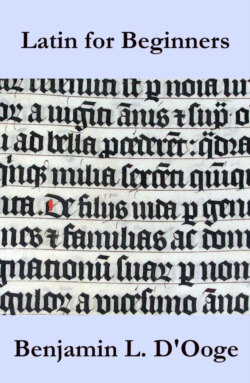Читать книгу Latin for Beginners - BENJAMIN L. D’OOGE - Страница 15
На сайте Литреса книга снята с продажи.
QUANTITY
Оглавление«11.» The quantity of a vowel or a syllable is the time it takes to pronounce it. Correct pronunciation and accent depend upon the proper observance of quantity.
«12.» «Quantity of Vowels.» Vowels are either long (¯) or short (˘). In this book the long vowels are marked. Unmarked vowels are to be considered short.
1. A vowel is short before another vowel or h; as «pŏ-ē´-ta», «tră´-hō».
2. A vowel is short before nt and nd, before final m or t, and, except in words of one syllable, before final l or r. Thus «a´-mănt», «a-măn´-dus», «a-mā´-băm», «a-mā´-băt», «a´-ni-măl», «a´-mŏr».
3. A vowel is long before nf, ns, nx, and nct. Thus «īn´-fe-rō», «re´-gēns», «sān´-xī», «sānc´-tus».
4. Diphthongs are always long, and are not marked.
«13.» «Quantity of Syllables.» Syllables are either long or short, and their quantity must be carefully distinguished from that of vowels.
1. «A syllable is short»,
a. If it ends in a short vowel; as «ă´-mō», «pĭ´-grĭ».
NOTE. In final syllables the short vowel may be followed by a final consonant. Thus the word «mĕ-mŏ´-rĭ-ăm» contains four short syllables. In the first three a short vowel ends the syllable, in the last the short vowel is followed by a final consonant.
2. «A syllable is long»,
a. If it contains a long vowel or a diphthong, as «cū´-rō», «poe´-nae», «aes-tā´-te».
b. If it ends in a consonant which is followed by another consonant, as «cor´-pus», «mag´-nus».
NOTE. The vowel in a long syllable may be either long or short, and should be pronounced accordingly. Thus in «ter´-ra», «in´-ter», the first syllable is long, but the vowel in each case is short and should be given the short sound. In words like «saxum» the first syllable is long because x has the value of two consonants (cs or gs).
3. In determining quantity h is not counted a consonant.
NOTE. Give about twice as much time to the long syllables as to the short ones. It takes about as long to pronounce a short vowel plus a consonant as it does to pronounce a long vowel or a diphthong, and so these quantities are considered equally long. For example, it takes about as long to say «cŭr´-rō» as it does «cū´-rō», and so each of these first syllables is long. Compare «mŏl´-lis» and «mō´-lis», «ā-mĭs´-sī» and «ā-mi´-sī».
